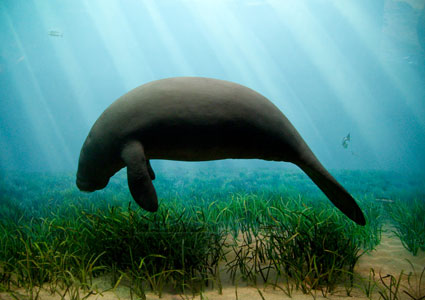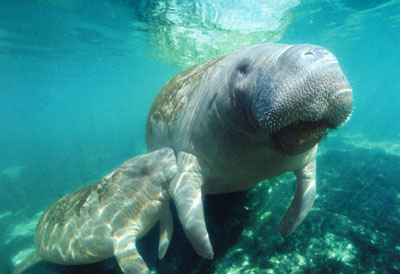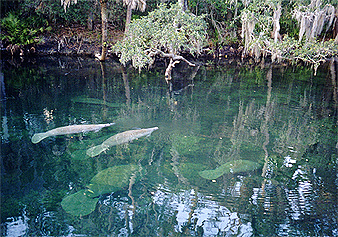Pinky Expedition: Manatee Musings
Posted by: Loren Coleman on March 17th, 2008

Various interviews I’ve had with St. Johns River and Lake Monroe area residents who remember the news reports from the 1950s still do feel that the reports were merely “Northern” tourists who saw unusual (but known) animals in the local waters. The number one candidate: manatee.

Manatees generally do stay below the surface, but have to come up for air, of course. Reflective of the lower population density in the 1950s, they may have been a rather surprising sight.
Some manatees do, also, have light gray to pinkish looking skin, in various light or water conditions.

There are five species of Sirenia, but scientists believe that there were many more in the past. Early forms of manatees are thought to have originated near the Amazon basin in South America. Some remained there to become the Amazonian manatee (Trichechus inunguis), while others migrated up through the Caribbean, giving rise to the Antillean (Trichechus manatus manatus) and Florida manatees (Trichechus manatus latirostris). Another group managed to swim or were carried on currents across the Atlantic and became the West African manatee (Trichechus senegalensis).
Dugongs, known by the scientific name as Dugong dugong, are thought to have evolved along with manatees, and they once ranged from Europe to Africa, and along the east and west coasts of the Americas. At the present time, they are found only in the Eastern Hemisphere in the Indian and Pacific Oceans.
Steller’s sea cow (Hydrodamalis gigas), another species of Sirenia, [allegedly] became extinct in the 1700s. ~ Source.

Does part of the answer to Lake Monroe Monster, at least, rest with the manatee?
Go observe for yourself.
One of the best places to see manatees up close is Blue Springs State Park in Orange City, Florida. I highly recommend it.

About Loren Coleman
Loren Coleman is one of the world’s leading cryptozoologists, some say “the” leading living cryptozoologist. Certainly, he is acknowledged as the current living American researcher and writer who has most popularized cryptozoology in the late 20th and early 21st centuries.
Starting his fieldwork and investigations in 1960, after traveling and trekking extensively in pursuit of cryptozoological mysteries, Coleman began writing to share his experiences in 1969. An honorary member of Ivan T. Sanderson’s Society for the Investigation of the Unexplained in the 1970s, Coleman has been bestowed with similar honorary memberships of the North Idaho College Cryptozoology Club in 1983, and in subsequent years, that of the British Columbia Scientific Cryptozoology Club, CryptoSafari International, and other international organizations. He was also a Life Member and Benefactor of the International Society of Cryptozoology (now-defunct).
Loren Coleman’s daily blog, as a member of the Cryptomundo Team, served as an ongoing avenue of communication for the ever-growing body of cryptozoo news from 2005 through 2013. He returned as an infrequent contributor beginning Halloween week of 2015.
Coleman is the founder in 2003, and current director of the International Cryptozoology Museum in Portland, Maine.










I was out on a guided ocean fishing trip a few years leaving from the St. Johns River into the Atlantic and was chatting with one of the crew. He talked about his Dad growing up in the depression in the area around New Smryna, Florida, and that manatee was frequently on the dinner menu. He said it tasted pretty good with its high fat content! The other “pink” meat?!
Yes, manatees look pretty unusual. I have no trouble believing that they are behind many cryptid sightings. The pink dolphin of the Amazon with its “out of shape” body and long neck looks even more unsual. Since I saw the Sirenia chart, isn’t the Steller’s Sea Cow one of the most neglected cryptids in the world?
I could see a part of it, but weren’t there some reports with the thing completely out of the water? Something with a neck? Dugongs/mantatees (which one it actually was is debated based solely on translation) are actually mentioned in the Old Testament, in the Bible. When they built the tabernacle (portable temple for the 40 year walk) the skin was used as a wall/covering of some sort.
The operative words here are “part” and “portion.” I’m talking about figuring out what various known animals might be the probable answers to some of the sightings.
There is no way that a permanently water-captured mammal could be the source of the larger bodied, land-based “dinosaur” reports, bipedal or otherwise. 🙂
I ALSO have a hard time believing a manatee could be the “answer” behind a creature sticking its NECK out of the water.
A river dolphin could stick its neck out of the water. But it sure could not run on its flippers.